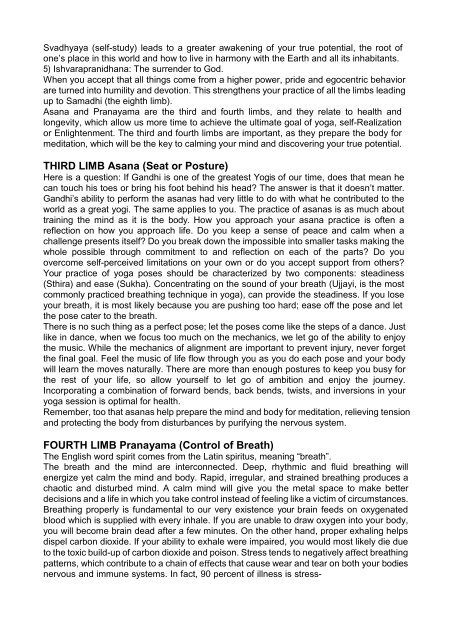MODUAL 1
Create successful ePaper yourself
Turn your PDF publications into a flip-book with our unique Google optimized e-Paper software.
Svadhyaya (self-study) leads to a greater awakening of your true potential, the root of<br />
one’s place in this world and how to live in harmony with the Earth and all its inhabitants.<br />
5) Ishvarapranidhana: The surrender to God.<br />
When you accept that all things come from a higher power, pride and egocentric behavior<br />
are turned into humility and devotion. This strengthens your practice of all the limbs leading<br />
up to Samadhi (the eighth limb).<br />
Asana and Pranayama are the third and fourth limbs, and they relate to health and<br />
longevity, which allow us more time to achieve the ultimate goal of yoga, self-Realization<br />
or Enlightenment. The third and fourth limbs are important, as they prepare the body for<br />
meditation, which will be the key to calming your mind and discovering your true potential.<br />
THIRD LIMB Asana (Seat or Posture)<br />
Here is a question: If Gandhi is one of the greatest Yogis of our time, does that mean he<br />
can touch his toes or bring his foot behind his head? The answer is that it doesn’t matter.<br />
Gandhi’s ability to perform the asanas had very little to do with what he contributed to the<br />
world as a great yogi. The same applies to you. The practice of asanas is as much about<br />
training the mind as it is the body. How you approach your asana practice is often a<br />
reflection on how you approach life. Do you keep a sense of peace and calm when a<br />
challenge presents itself? Do you break down the impossible into smaller tasks making the<br />
whole possible through commitment to and reflection on each of the parts? Do you<br />
overcome self-perceived limitations on your own or do you accept support from others?<br />
Your practice of yoga poses should be characterized by two components: steadiness<br />
(Sthira) and ease (Sukha). Concentrating on the sound of your breath (Ujjayi, is the most<br />
commonly practiced breathing technique in yoga), can provide the steadiness. If you lose<br />
your breath, it is most likely because you are pushing too hard; ease off the pose and let<br />
the pose cater to the breath.<br />
There is no such thing as a perfect pose; let the poses come like the steps of a dance. Just<br />
like in dance, when we focus too much on the mechanics, we let go of the ability to enjoy<br />
the music. While the mechanics of alignment are important to prevent injury, never forget<br />
the final goal. Feel the music of life flow through you as you do each pose and your body<br />
will learn the moves naturally. There are more than enough postures to keep you busy for<br />
the rest of your life, so allow yourself to let go of ambition and enjoy the journey.<br />
Incorporating a combination of forward bends, back bends, twists, and inversions in your<br />
yoga session is optimal for health.<br />
Remember, too that asanas help prepare the mind and body for meditation, relieving tension<br />
and protecting the body from disturbances by purifying the nervous system.<br />
FOURTH LIMB Pranayama (Control of Breath)<br />
The English word spirit comes from the Latin spiritus, meaning “breath”.<br />
The breath and the mind are interconnected. Deep, rhythmic and fluid breathing will<br />
energize yet calm the mind and body. Rapid, irregular, and strained breathing produces a<br />
chaotic and disturbed mind. A calm mind will give you the metal space to make better<br />
decisions and a life in which you take control instead of feeling like a victim of circumstances.<br />
Breathing properly is fundamental to our very existence your brain feeds on oxygenated<br />
blood which is supplied with every inhale. If you are unable to draw oxygen into your body,<br />
you will become brain dead after a few minutes. On the other hand, proper exhaling helps<br />
dispel carbon dioxide. If your ability to exhale were impaired, you would most likely die due<br />
to the toxic build-up of carbon dioxide and poison. Stress tends to negatively affect breathing<br />
patterns, which contribute to a chain of effects that cause wear and tear on both your bodies<br />
nervous and immune systems. In fact, 90 percent of illness is stress-


